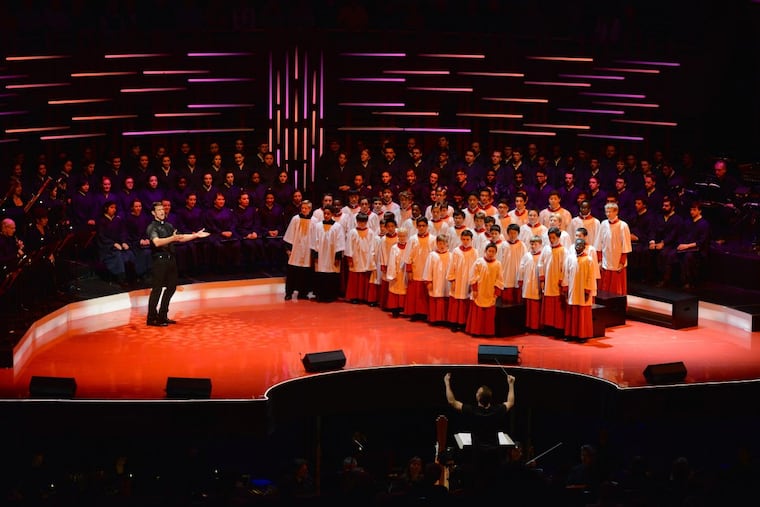Philadelphia Orchestra recording of Bernstein's Mass is a groovy - and powerful - '70s artifact
It may not be a masterpiece, but the Bernstein "Mass" only seems to gather relevance.

There ought to be a musical term for a work that is not, first and foremost, a piece of music. Bernstein's Mass is hung on a musical frame. But more saliently to most audiences, perhaps, it is religious, it is social, it is political. The piece is also, in the nearly suffocating blast of activity around the centennial of Bernstein's birth, about remembering who the composer/conductor really was: a man with a great flair for theatrics.
Whether the Mass can be heard as pure music — listening as you might do with, say, a Haydn symphony — is something listeners get to decide for themselves with the just-released Deutsche Grammophon recording by the Philadelphia Orchestra and a battery of forces led by Yannick Nézet-Séguin.
Is the piece better off as a live, shared social experience? Probably.
The recording, drawn from Verizon Hall concerts between April 30 and May 3, 2015, has tremendous energy. But, of course, it can't deliver exactly what the Mass' subtitle promises: "a theatre piece for singers, players and dancers."
Rather, conceived by Bernstein and Godspell composer-lyricist Stephen Schwartz, the Mass comes across in recording as an erratic aural trek through music theater, sacred music, rock, classical, jazz, carnival music, and parade music, with a little Copland and more Blitzstein, and on and on.
Maybe the technical term for it all is simply this: groovy.
 And nostalgic. The piece was written to help celebrate the opening of the Kennedy Center in Washington in 1971. It sounds like the ’70s. Authentic listening practice would involve sitting in a dark room with incense burning and psychedelic posters aglow under black lights. It is pure America.
And nostalgic. The piece was written to help celebrate the opening of the Kennedy Center in Washington in 1971. It sounds like the ’70s. Authentic listening practice would involve sitting in a dark room with incense burning and psychedelic posters aglow under black lights. It is pure America.
The impending world premiere of the piece drew the interest of the F.B.I. — which was often fixated on Bernstein — and the White House, fearing it would arrive embedded with antiwar messages, as New Yorker music critic Alex Ross wrote several years ago. At one point, the nation's commander-in-chief was caught on tape asking about musical form.
"Is it an opera?" President Richard M. Nixon asked his chief of staff, H.R. Haldeman.
Haldeman, Ross writes, explained that it was, in fact, a Mass, although he characterized it as "weird."
Haldeman was a more perceptive music critic than he knew. The Mass is weird. In fact, it is at its best when at its weirdest. There's a 10-minute stretch toward the beginning that starts with the well-known "A Simple Song" and that is remarkable for its ability to take you, spiritually, outside the concert hall.
"The Celebrant," sung by tenor Kevin Vortmann, sings his pop-inspired song, and then the responding "Alleluia" from six solo voices sounds like the Swingle Singers gigging for a 1960s chamber of commerce spot. A street chorus and marching-style band come in with a touch of Ives.
The "In nomine Patris" arrives in the guise of a Middle Eastern dance. And then comes a quiet hymnlike blessing robed in the pure colors of a choir.
The sequence — from pop to commercial to Americana and Middle Eastern to hymn — is an extraordinary unfolding of musical ideas and pure inspiration. It also underscores the key message of the Mass: from diversity come beauty and strength.
It's a Mass, but one with a plot that veers. There is devotion, but also disillusionment with institutions of all sorts and a journey back that leaves one feeling changed. It uses Roman Mass liturgy but also contains lines like this, contributed by Paul Simon:
Half of the people are stoned
and the other half are waiting for the next election.
Half of the people are drowned
and the other half are swimming in the wrong direction.
Nézet-Séguin might seem like just a bystander amid all the activity, but the fact that this recorded account is as coherent as it is attests to his multitasking strengths.
Something does get lost in this wild rumpus and resolution. The piece is scored for choirs, "street singers," a marching band, dancers, solo singers, organs, synthesizers, electric guitars, and a blues band. Though the orchestra is present in various configurations, it only sometimes surfaces as the primary presence.
Rising up at one point is a melody that shares the first few notes of "Somewhere" from West Side Story, and the string passage that follows catches the Philadelphians in especially poignant form.
Liner notes suggest a journey for the Mass that rests on being "excoriated" in a New York Times review at the time of its premiere ("cheap and vulgar," the critic wrote), and ending up this half-century later considered a masterpiece (though this critical assessment is not attributed to anyone in particular).
Masterpiece? Probably not. But it is a powerful artifact, a musical and theatrical response to a deeply troubled time that has cycled back into even greater relevance in the three years the recording has been in the can. That's more benefit accruing to the common good than can be claimed for many a masterpiece.